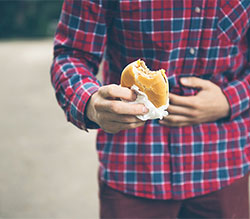Food Safety
Resources
To ensure the safety of food for consumption in suburban Cook County (excluding Oak Park, Stickney Township, Evanston and Skokie), CCDPH’s food safety program :
- inspects food establishments and responds to food complaints in unincorporated areas and 29 incorporated contract towns
- issues retail licenses to food establishments in unincorporated areas
- investigates foodborne illnesses resulting from eating in a food establishment
- grants permits for temporary food establishments in unincorporated areas
- reviews cottage food applications
Contact Information
To request an inspection in unincorporated Cook County, please contact George Papadopoulos .
To request an inspection in one of our 31 contract towns contact Kamala Nagaraj at 847-818-2844.
To apply for a license in unincorporated Cook County, please contact George Papadopoulos .
To report a foodborne illness, please call 708-836-8699 or use our complaint form so we may begin an investigation.
To file a restaurant complaint, contact Kamala Nagaraj at 847-818-2844 or use our complaint form.
Health Department Offers Tips for Holiday Food Safety
The holiday season is here, and celebrations will be different, especially for those who decide to stay home and host virtual gatherings with family and friends to slow the spread of COVID-19. In addition to washing your hands often, watching your distance and wearing a mask, Cook County Department of Public Health reminds you to follow food safety tips when cooking, baking and sharing holiday favorites.
There are four steps to food safety: Clean, Separate, Cook and Chill:
- Clean – Clean your hands, surfaces, and utensils with soap and water before cooking. After cleaning surfaces where raw poultry has touched, remember to re-sanitize.
- Separate – Use separate cutting boards, plates, and utensils to avoid cross-contamination between raw meat and foods that are ready to eat. Juices from raw meat and poultry are likely to contain harmful bacteria such as Salmonella and E. coli. While these bacteria can be destroyed with proper cooking, it is important to keep these raw juices from touching food that won’t be cooked.
- Cook – Use a thermometer to check if the turkey is cooked. You cannot tell by looking if it is fully cooked. Turkey should be cooked to 165° F. Take the temperature in three places – the thickest part of the breast, the innermost part of the thigh, and the innermost part of the wing.
- Chill – Do not leave foods at room temperature more than two hours. After you are done eating, divide the remaining food into small containers and either refrigerate or freeze. Leftovers are safe in the refrigerator for up to four days.
An easy way to remember is to keep hot foods hot, and cold foods cold. After being cooked to a safe temperature, hot foods should not be allowed to get cooler than 140° F. Cold foods should not be allowed to become warmer than 40° F. Bacteria grow most rapidly in the range of temperatures between 40° F and 140° F. This range of temperatures is commonly referred to as the “Danger Zone.”
Updated June 23, 2023, 2:07 PM






